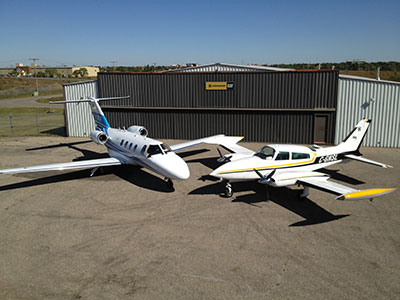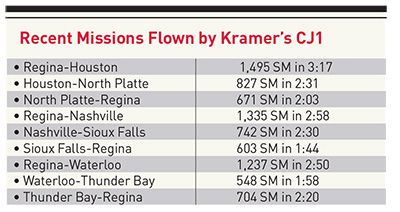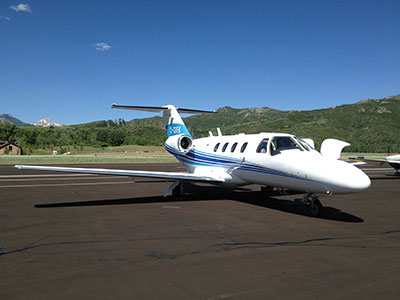
Features
Operations
Matching the missions
During the past 70 years, Saskatchewan’s economy has grown substantially, but more importantly it has shifted away from being agriculturally centric.
May 7, 2014 By Frederick K. Larkin
During the past 70 years, Saskatchewan’s economy has grown substantially, but more importantly it has shifted away from being agriculturally centric. This diversification has come with the development of additional natural resources that have experienced significantly increased demand from around the world.
 |
|
| Saskatchewan agricultural firm Kramer Inc. has been servicing customers with its reliable BizAv fleet for years. Photo: kramer ltd.
|
The province’s first potash deposits were discovered in 1942. Since then, the increased global demand for fertilizers has resulted in a massive expansion of potash mining within Saskatchewan. Today the province holds close to half of the planet’s known potash reserves.
While the first Saskatchewan crude oil was found in 1944, major development of the oil fields began a decade later. Today, the province is the second largest Canadian producer of oil. Saskatchewan is also Canada’s third largest natural gas-producing province. During the early 1950s, major deposits of uranium were discovered in northern Saskatchewan. Today, the province represents approximately 15 per cent of the annual global uranium production.
Of course, crops continue to be an important sector for the province, as it is Canada’s largest grain and oil seed producing region and represents about 10 per cent of the world’s exported wheat.
Any efforts to extract/harvest these commodities require specialized machinery and the world’s leading manufacturer of such equipment is Caterpillar Inc. of Peoria, Illinois. The sole CAT dealer in Saskatchewan is Kramer Ltd. of Regina. This 70-year old family-owned outfit, currently in its third generation, has long been a believer in the advantages offered by business aviation. As such, it provides an excellent example of how the right fleet can enhance the business prospects of a company’s customers as well as itself.
The Company
Robert A. Kramer signed on as a dealer for Caterpillar Tractor Company on June 1, 1944. He and his younger brother, Thomas, joined Clarence Church, who was at the time the western Canadian representative of CAT, to create Kramer-Church Tractor Co. Ltd. in Regina. That year, Tom established the first branch office at Saskatoon. Three years later, with the sudden passing of Church, the company was renamed the Kramer Tractor Company, Ltd.
Donald E. Kramer, Bob’s eldest child, joined the firm in 1948 after graduating as an engineer from university. He became general sales manager in 1958 and was appointed president in 1980 when his father retired. To reflect its expanded product offerings, the company was renamed Kramer Ltd. in 1991.
Timothy R. Kramer, a son of Don, had joined the firm upon graduation from university in 1978. He became president in 1995 when his father became chairman.
All three of these gentlemen have had – and continue to have – a keen appreciation for the usefulness of aircraft in attracting and maintaining customers. Kramer’s relationship with aviation began back in the late 1940s when it was installing and servicing Caterpillar diesel generators that were operated by numerous communities that had not yet been connected to the Saskatchewan Power Commission’s grid. Given the primitive road network across the province back then, Bob Kramer looked for a more efficient way of serving his wide spread customer base. The solution was the purchase of an airplane in 1947. That four-seat Stinson 108-2 Flying Station Wagon (CF-EXR) began a relationship that has lasted almost seven decades.
Today, Kramer boasts more than 400 employees at seven locations across Saskatchewan, including Estevan, Kindersley, North Battleford, Regina, Saskatoon, Swift Current and Tisdale. The company serves customers in the agricultural, construction, electrical power generation, forestry, mining, natural gas and oil industries. As well, its supports the operations of highway transport truckers, landscapers and material handlers. It not only sells new and used equipment, but also provides parts and service and rentals of equipment.

|
|
The Fleet
Kramer’s first aircraft was a stalwart, albeit stodgy, Stinson. It was later replaced with a relatively seductive Cessna 195 (CF-GGF). Equipped with a Jacobs radial engine, the high-winged strutless speedster could carry a pilot and four passengers 800 miles while cruising at 170 mph.
For a brief period, the company ventured into aviation as a commercial operator. In 1950, Kramer Air Services Ltd. was created as a Cessna Aircraft dealer. It later offered charters with a fleet of Cessnas that included 140s, 170s, 180s and the 195. It eventually became apparent that Kramer should stick to what it knew best – the heavy equipment business. Several years later, it sold the operation to a group of investors that renamed it Prairie Flying Service Ltd.
Fifty years ago, the Kramer fleet was comprised of a Cessna 185A (CF-OJC) and a rather exotic de Havilland DH-104 Dove 6A (CF-HGR). The latter was a cabin-class twin that could move six passengers 880 miles at a speed of 185 mph. Proving to be a less than stellar performer, the Dove was eventually sold. During the following two decades, Kramer sequentially operated a Cessna 337A Super Skymaster (CF-VID), a 337F (CF-FXS) and a 310R (C-GBIK).
Since 1984, Kramer has operated a Cessna T310R (C-GNSL). In early 2012, it took delivery of its first turbine aircraft – a Cessna 525 CitationJet CJ1 (C-GDEK).
The Operations
Transporting customers to see new products in one of Kramer’s showrooms, taking managers around to oversee branch operations or carrying a part that is urgently required to keep a machine running are just a few examples of how an aircraft earns its keep. Tim Kramer notes that he can travel with senior managers to three facilities and have the team members back home in time for dinner the same day.
Murray Grant, a long-time former marketing manager who spent many hours aboard Kramer aircraft, remembers the days when getting to and from the Caterpillar factory in Peoria took the better part of a week via scheduled airlines and required stops in Winnipeg, Toronto and Chicago. Today, the same journey can be accomplished in a day. Not all Kramer flights have been strictly business related, as he recalls. For example, there have been numerous occasions when an aircraft would act as an ambulance to retrieve an injured individual from a remote location.
Kramer’s two current Cessnas were designed for distinctly different roles and are dispatched accordingly. During most of the past 30 years, the 310 has flown throughout North America. Today, however, it primarily operates within Saskatchewan. Equipped with a STOL kit, it can easily deal with the many short strips scattered across the province. Tim Kramer, a 4,000-hour pilot, notes that at times, the 310 has been used as a “half-ton truck” in getting parts to out-of-the-way locations. Typical annual utilization of the light twin is between 150 and 200 hours.
The CJ1 performs all of the out-of-the-province flying and includes a great deal of travel to the U.S. Patrick Donohue, Kramer’s aviation manager and chief pilot, notes that the company is sensitive about the load factor on the jet, so it tends to fly with very few, if any, empty seats. Nonetheless, the airplane has been experiencing 350 to 400 hours of flight time per year. Donohue points out that Kramer has flown customers to view Caterpillar plants in numerous locations, including Decatur, Ill; Peoria, Ill; LaGrange, Ga; Little Rock, Ark; and Minneapolis, Min.
A review of C-GDEK’s recent activity on flightaware.com provides examples of recent missions flown that are shown in the accompanying table (see previous page).
Although Kramer’s aircraft share a dedicated hangar at CYQR, all maintenance work is contracted out. While the jet is looked after in Calgary, the 310 is maintained in Regina by Prairie Flying Service – the surviving entity of Kramer’s former aviation venture.
The BizAv advantage
Many decades ago, Kramer learned that time spent aboard an aircraft with any given client is extremely valuable – not only in terms of getting to know the individual, but in gaining insight into the attributes and requirements of their particular business. Such bonding between a customer and a supplier can be difficult, if not impossible, to accomplish in any other manner.
 |
|
| In early 2012, Kramer added its first turbine aircraft – a Cessna 525 CitationJet CJ1 (C-GDEK). Photo: Kramer Ltd.
|
In addition to generating new business, as well as repeat orders, Kramer has long known that the use of its own aircraft enhances operating productivity and boosts its esprit de corps.
An excellent example is best described by Tim Kramer: “One of our more lucrative encounters that can be directly attributed to the use of our corporate aircraft came early in my career with our dealership,” he says. “I was contacted by the director of purchasing for a pulp and paper mill in northern Saskatchewan. The client had expressed displeasure with the level of support received from his current heavy equipment supplier. He wanted to meet as soon as possible to establish a new relationship for sales and support. My response was, ‘I will be in your office in an hour-and-a-half.’ His response was, ‘We’ll see.’ True to my word, and to his astonishment, I was in his office in an hour-and-a-half because of the magic of flight. That day spawned 30 years of respect and friendship on both sides. Customer/supplier trust was established to the great benefit and profitability for both firms.”
The Future
Kramer’s customers include family-owned and operated farms, construction and trucking companies, as well as massive international corporations. While its clients may differ in size, their needs are all dealt with in the manner outlined in the company’s mission statement: “We take pride in making our customers more profitable by providing safe, innovative, cost-effective solutions.”
A key part of living up to customers’ expectations is the ability to deliver critical components and related service personnel to a site in a timely fashion. As Bob Kramer realized almost seven decades ago, only an aircraft can provide the type of high priority logistical support that is required in a territory as large as that served by his company today.
Given Kramer’s long held appreciation for business aviation, it seems safe to assume that “Kramair” will continue to deliver value for the company and its customers by matching the missions with appropriate aircraft in decades to come.